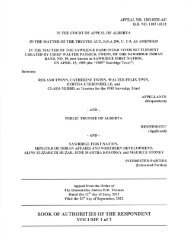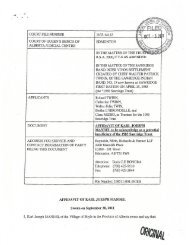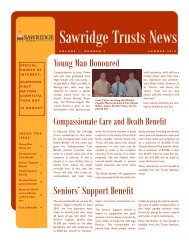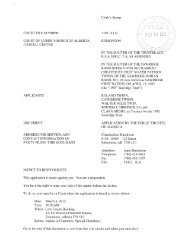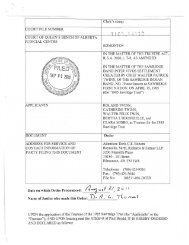31420-12-1 SAWRIDGE, Indian vs. ROLAND, Twinn et al
31420-12-1 SAWRIDGE, Indian vs. ROLAND, Twinn et al
31420-12-1 SAWRIDGE, Indian vs. ROLAND, Twinn et al
You also want an ePaper? Increase the reach of your titles
YUMPU automatically turns print PDFs into web optimized ePapers that Google loves.
F19<br />
1 Certainly we would say that the Public Trustee do a very fine job of making those<br />
2 arguments as well. And if they wish to be here voluntarily, we wouldn’t have difficulties.<br />
3 But we don’t think there’s a need necessarily for a litigation representative. When my<br />
4 friend has said we had an obligation because when there’s an adversari<strong>al</strong> process, there’s<br />
5 anobligation. We absolutely take the position that that is not adversari<strong>al</strong>, that we are<br />
6 coming here for an advice and direction application. We expect to be fully open with<br />
7 respect to <strong>al</strong>l the groups that are going to be affected, <strong>al</strong>l the solutions that are possible,<br />
8 and certainly as I said, there will be other parties who will make those submissions as<br />
9<br />
10<br />
well.<br />
11 The trustees aren’t here to win in the main application. They’re here to seek direction.<br />
<strong>12</strong><br />
13<br />
And Ithink that’s a very important distinction.<br />
14 I would agree that we perhaps have been a bit more aggressive in this preliminary<br />
15 application. But that’s because the trustees feel very obligated to protect the trust ass<strong>et</strong>s.<br />
16 And so the main concern we have is the direction that we would have to pay costs to the<br />
17 Public Trustees. These ass<strong>et</strong>s belong to the beneficiary. They hope to use these ass<strong>et</strong>s for<br />
18 many years to come, for children and seniors and many programs. And they do find it<br />
19 astounding that they would want -- that they would have to pay the government to be<br />
20<br />
21<br />
involved. Especi<strong>al</strong>ly when no one, no one has asked the Public Trustee to be involved.<br />
22 THE COURT: Just aminute. I’ve got a couple of questions<br />
23<br />
24<br />
that have piled up here.<br />
25 MS. BONORA:<br />
26<br />
Yes.<br />
27 THE COURT: Now, you, just a few minutes ago, you referred<br />
28 to the government asking to be paid, I think were the words you used. Are you saying as<br />
29 a matter of law that the Government of Alberta and the Public Trustee are one and the<br />
30<br />
31<br />
same or?<br />
32 MS. BONORA: Well, I suppose it is a -- you know, it is the<br />
33 Office of the Public Trustee. It is part of the Government of Alberta. And so it’s<br />
34 definitely a government department. I certainly haven’t investigated their links to the<br />
35<br />
36<br />
government, but --<br />
37 THE COURT: Well, Ithink you’ll find in the legislation it’s a<br />
38 pr<strong>et</strong>ty independent office, if I can -- it’s a statutory office. And I’m sure counsel for the<br />
39 Public Trustee will sort of guide me to the provisions in the Act which make that quite<br />
40 clear. And I’m raising it because we hear this <strong>al</strong>l the time in many of these other cases<br />
41 that, in fact, you’re referring the Court to or that counsel are referring the Court to. All



